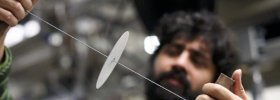Humanity has evolved to the point where we can regenerate our arms
Around the world there’s about 2 million hand amputees but many willl live without a replacement worldwide as a bionic limb can cost up to £80,000. One company has invented a way to make this form of medicine more accessible and affordable to all.
When children lose a limb it gets complicated. Since they are still developing, it follows that they will regularly outgrow their news arms and legs, which remain static.
A growing adolescent will need a new robotic arm every few years to keep up with their growth. When we are at our most exuberant stages of development the changes will be even more rapid. This phase of rapid growth inevitably coincides with the teenage years, which are an emotionally turbulent time for anyone, especially those who are slighlty different from their peers.
The standard process for creating a false limb is quite involved too. The waiting time is often agonising, with multiple consultations and fittings. If an amputee is going through a teenage growth spurt there is a danger that the limb wont fit by the time it’s been created.
With the help of investment and mentoring from Nominet Trust, inventor Joel Gibbard at Open Bionics has created a better way that shortens the creative proceses and takes out many stages of each project. Gibbard did this by finding a new use for using thermoplastic elastomer, a flexible plastic that can be crafted into shape by a 3-D printer.
The result is a much more affordable bionic hand. By making production more accessible to more suppliers, it allows new replacement limbs to be created much quicker.
It can take the best part of half a year to get a replacement limb, depending on how your appointment works out. The user is 3D-scanned and a tailor-made bionic limb and socket are printed in a matter of days. The pieces can be assembled in two hours and the final fitting takes place in less than a week after the initial assessment. By contrast the standard waiting time for replacment limbs, by tradition, is around three months. But how many of us are lucky enough to enjoy standard waiting time? There are always complications.
The robotic hand itself makes use of the latest technology concepts and has a sort of Internet of Things capacity. It responds to sensors that pick up muscle movements from the wearer’s skin, allowing users to control the opening and closing of the hand. Sensors in the fingers relay back to the amputee to let them know the amount of force they are using. Amazingly, all this is achieved for a relatively low price of £2,000. This is possible because the IoT industry has matured, standards are evolving and mass manufacture of components is driving down prices.
Bristol-based Open Bionics worked with Disney’s Tech Accelerator Program in Los Angeles, where Gibbard developed a range of superhero-themed bionic hands for children. The range includes an Iron Man arm, a lightsaber-inspired Star Wars arm and from Disney’s Frozen, a glittery snowflake-adorned arm.
Open Bionics won the prestigious James Dyson Award in 2015. Gibbard was named Young Design Engineer of the Year at the British Engineering Excellence Awards in 2014. However the creation of a new company takes a lot longer than the re-generation of a new limb and the company is still in its infancy.
When growth is stimulated in the company, the benefits to society could be immense. It would cost £160 million to supply replacement hands to everyone in the world who has been affected by accident or disease. By extension, creating a relacement for one fortieth of the price would cost £40 million. So Joel Gibbard at Open Bionics has saved £120 million but, more importantly, his inventiveness could improve 2 million lives and spread their hapiness and productivty to all the people around them. The joy that brings to people is immeasurable.
We don’t quite have the powers of regeneration of some species (such as Starfish) which can re-grow lost limbs, but humanity has evolved to the point where we can self generate our own non-organic alternatives.








